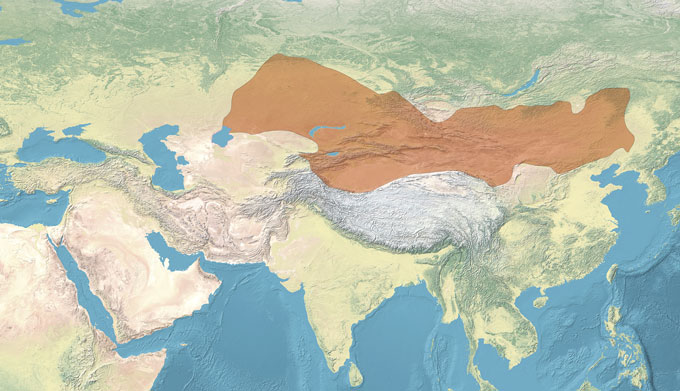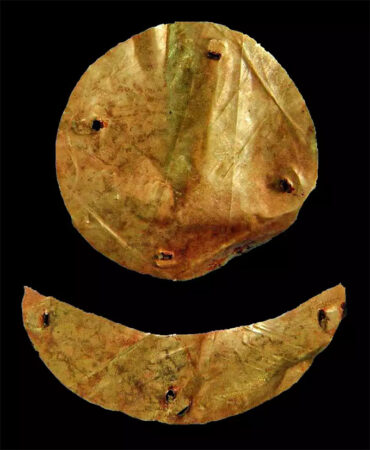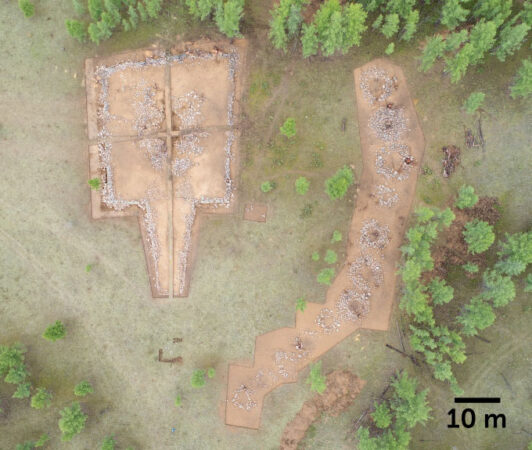How Asia’s first nomadic empire broke the rules of imperial expansion
In an age that spawned the ancient Roman and Egyptian empires, Mongolia’s Xiongnu Empire broke the rules of imperial expansion.
Long before the Mongol Empire arose, Asia’s first nomadic empire, horse-riding Xiongnu people, conquered ethnic groups across the continent’s northeastern and central expanses (SN: 1/29/10). A common political system headed by Xiongnu imperial rulers formed about 209 B.C. and lasted for roughly 300 years. Unlike in Rome or Egypt, mobile groups of Xiongnu animal herders accomplished this feat without building cities, forming central bureaucracies, devising a writing system or mobilizing masses of farmers to produce food.
Today, remnants of Xiongnu culture largely consist of more than 7,000 tombs, some heavily looted and many yet to be excavated, in Mongolia and nearby parts of China and Russia. In the last decade, geneticists and archaeologists have ramped up efforts to study these sites and ancient records to decipher the Xiongnu Empire’s political organization and technological achievements.

A few ancient Chinese chronicles include descriptions of the Xiongnu political system. These accounts portray the Xiongnu as predatory raiders who belonged to a “simple” confederation of herding groups run by a few nomadic alpha males. Even so, warfare with mounted Xiongnu warriors equipped with bows, arrows and metal weapons had inspired Imperial Chinese leaders to construct their Great Wall.
Some researchers have argued that Xiongnu people formed a lesser, “shadow empire” alongside Imperial China. But that view is giving way to a picture of the Xiongnu Empire as a different, not lesser, type of ancient state, says Yale University archaeologist William Honeychurch.
In this view, nomadic Xiongnu elites developed a flexible system of political power that connected mobile groups with different genetic and cultural ancestries spread across extensive grasslands and forests. “Elite lineages were not only an important part of a multiethnic Xiongnu state, but members of these lineages were sent to peripheral areas as part of state integration,” Honeychurch says. One new study, for example, indicates that Xiongnu women from elite lineages in central Mongolia served as “princess” emissaries to the empire’s frontier, assuming political power in distant territories populated by various ethnic groups.
“This must have been an empire organized around moving populations,” says archaeologist Bryan Miller of the University of Michigan in Ann Arbor. “Xiongnu elites were savvy politicians who delegated power to keep the empire together.”
In another recent development, excavations in Central Mongolia point to Xiongnu people as early ironworking innovators whose advances spread to their regional neighbors. These discoveries, and others, highlight the unappreciated complexity and the ongoing mystery of how Xiongnu society worked, researchers say.
The Xiongnu dispatched frontier ‘princesses’
Initial insights into the Xiongnu people’s diverse genetic origins were first published in 2020. DNA extracted from remains of 60 individuals excavated at 27 Xiongnu sites indicated that two genetically distinct populations of Mongolian herders had coalesced to become the Xiongnu people around 2,200 years ago. One population descended from several western Mongolian cultures and the other from a couple of eastern Mongolian cultures.
Additional genetic contributions to the Xiongnu mix then came from farther away, most likely a culture near present-day Ukraine as well as Imperial China, reported archaeogeneticist Choongwon Jeong of Seoul National University in South Korea and colleagues.
Building on those findings, Jeong’s team then examined DNA of 17 individuals from elite and low-status graves at two Mongolian cemeteries on the Xiongnu Empire’s western frontier. Central Mongolia’s Xiongnu heartland lay around 1,200 kilometers to the east.
The six largest and richest tombs contained women whose genetic ancestry traced back to central Mongolia, the scientists reported in April in Science Advances. These women rested in wooden coffins placed in square tombs. Items found in these tombs included gold sun and moon emblems of Xiongnu imperial power, glass beads, silk clothes and Chinese mirrors.

One woman was buried with horse-riding equipment, a gilded iron belt clasp and a Chinese lacquer cup. These objects have previously been found in graves of male horse-mounted warriors. But such items signal that a deceased person had been powerful, not necessarily a warrior, says Miller, a study coauthor.
Miller and his colleagues suggest that the women had been sent to the frontier to maintain Xiongnu traditions and nurture contacts with Silk Road trade networks (SN: 3/8/17). Preliminary signs of genetic relatedness among individuals interred at one of the cemeteries suggest that some elite Xiongnu “princesses” also cemented power by marrying into local families.
The elite women’s graves were flanked by simple graves of adult men, and of girls and boys ranging from babies to adolescents. These commoners possessed greater genetic diversity than the female big shots. If the men were retainers or servants of female elites, they had come from distant parts of the Xiongnu Empire or possibly beyond, the researchers say.
Male rulers were homebody ‘princes’
Like these female elites, premier Xiongnu rulers had common roots in central Mongolia while their followers had diverse geographic origins, another team reports in the June Archaeological Research in Asia. But rather than being sent to the far reaches of the empire, these rulers stayed close to home.
Three male nobles interred in large underground tombs at one of the largest Xiongnu cemeteries, Gol Mod 2, spent most or possibly all their lives in the Khanuy Valley where they were buried, say archaeologist Ligang Zhou of Henan Provincial Institute of Cultural Heritage and Archaeology in Zhengzhou, China and colleagues.
Meanwhile, at least four of eight individuals buried in some of the many small satellite graves situated near the nobles’ tombs had spent much of their lives in distant places before settling in or near the Khanuy Valley, measurements of different forms of the element strontium in individuals’ teeth and bones indicate. Diet-related strontium signatures, which vary from one region to another, signal where a person spent early and later parts of their lives.
The identities of those in satellite graves, who were apparently killed to form entourages of followers that accompanied deceased nobles, are unclear. They include children and adults, Zhou says. Some were buried with metal weapons or luxury objects such as jewelry.
Genetic and strontium findings suggest that “Xiongnu political organization in central and western Mongolia was highly similar,” Zhou says. Then, as the empire expanded, rulers in the Xiongnu heartland sent select members of their extended families, such as high-ranking women, to new territories in order to replicate the imperial power structure.

Iron innovations bolstered the Xiongnu Empire
From the start, Xiongnu imperial power depended on a ready supply of iron weapons and other gear that enabled horse-mounted warfare. Researchers who view the Xiongnu Empire as a faint version of Imperial China argue that the nomads’ power depended on importing crops and borrowing iron-making techniques, or simply trading for iron products, from the Chinese.
But new findings suggest that Central Mongolian metallurgists launched a regional boom in iron production around the time the Xiongnu Empire originated, says archaeologist Ursula Brosseder of the University of Bonn in Germany.
At a riverbank site, Brosseder and colleagues have excavated five iron smelting installations that contain by-products of iron making and burned wood. Radiocarbon dates of that material extend to as early as around 2,200 years ago, when the Xiongnu Empire arose.
That makes these finds, each of which consists of two pits connected by a tunnel, the oldest Xiongnu iron smelting kilns by at least 100 years, the researchers reported in March in Asian Archaeology.
Earlier research had established that people living just north of Xiongnu territory in southern Siberia started producing iron as early as around 2,800 years ago. Based on comparisons of finds in the two regions, Xiongnu metallurgists not only learned about iron making from their neighbors but also invented tunnel furnaces, the investigators say. Eastern Asian groups outside the Xiongnu sphere began making and using tunnel furnaces over the next couple of centuries.
Discoveries by Brosseder’s group “show that metallurgy reached the Xiongnu in Mongolia from southern Siberia, not China,” says archaeologist Nikolay Kradin, director of the Institute of History, Archaeology and Ethnology at the Far-Eastern Branch of the Russian Academy of Sciences in Vladivostok. Craftspeople at several iron-making centers, some slightly younger than Brosseder’s discoveries and others yet to be found, must have managed that technological transition, hypothesizes Kradin, who did not participate in the new research.
Brosseder suspects the Mongolian site she’s studied hosted a major iron-making operation. Four iron-making furnaces excavated near the other five have not yet been dated. And ground-based remote sensing equipment has revealed signs of at least 15, and possibly 26, more iron smelting kilns still covered by sediment.
“We can expect more findings of Xiongnu iron smelting centers considering the demand for iron horse gear, arrowheads, carts and other material by the empire’s large army,” Brosseder says.
No reliable estimates exist for the size of that army, or for the overall number of Xiongnu people, says Michigan’s Miller. Xiongnu herders, who also occasionally cultivated a grain called millet, moved across the landscape in relatively small groups that must have been greatly outnumbered by Imperial China’s estimated 60 million citizens.
The capital was a seasonal seat of power
In the same valley where Brosseder’s group discovered the oldest known Xiongnu iron smelting kilns, Mongolian researchers have uncovered remains of what was probably a Xiongnu political center, or perhaps even its capital, called Longcheng in 2020. Consistent with everything else about the Xiongnu Empire, “this was a capital of a different kind,” says Miller.
Longcheng excavations so far have focused on a large building that may have hosted important gatherings.
Roof tiles on that structure bear an inscription in ancient Chinese characters that reads “Son of Heaven Chanyu.” Chinese records refer to the supreme Xiongnu ruler as “chanyu.” That royal inscription, the only one found within the Xiongnu realm, identifies Longcheng as a seat of power, Miller says.
Rather than a permanent site, Longcheng, like several excavated Xiongnu villages and walled compounds in central Mongolia, served as a seasonal stopover or temporary meeting place, Miller suspects (SN: 11/15/17). “We don’t know if those other sites were separate political capitals for the Xiongnu,” he says. Top Xiongnu honchos gathered for part of the year at Longcheng before packing up and moving elsewhere, he speculates. Xiongnu herders, regardless of political status, navigated animals to seasonal grazing spots. Staying in one place throughout the year was not an option.
Having a flexible, mobile system of rule appears to have kept the nomadic realm rolling for a few hundred years before the Xiongnu Empire rapidly disintegrated about 1,900 years ago. Why it did so is an enduring mystery. Perhaps the empire succumbed to combined attacks by Imperial China and other groups or, in true nomadic fashion, Xiongnu people reorganized on a smaller scale and moved to safer areas.
Still, “the Xiongnu had created a massive imperial network in Asia,” Miller says. “Their ways of life didn’t go away overnight.” For instance, Xiongnu-mediated trading by groups situated along Central Asia’s Silk Road routes continued despite military defeats in the empire’s central Mongolian heartland. Only further archaeological and genetic discoveries can clarify how Xiongnu people in the imperial core responded to those setbacks.
Whatever happened, Asia’s first nomadic empire can likely be counted on for a few more surprises.
For all the latest Science News Click Here
For the latest news and updates, follow us on Google News.

